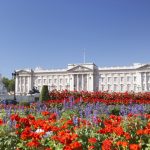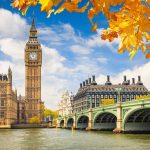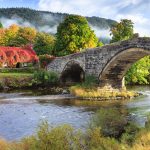From York’s cobbled streets to Oxford’s dreaming spires, from Bristol’s Floating Harbour to the Liverpool Docks, England’s cities are main attractions. London, of course, is the trump card: a trendsetter, history-maker and game changer for more than a thousand years, encompassing everything from royal residences to world-class museums, landmark theatres and vast urban parks. But there’s a varied urban landscape to explore outside London, too: delving into Manchester’s pulsing music scene, visiting Newcastle’s innovative art galleries, admiring Bath’s glittering Georgian architecture or browsing for bargains along Brighton’s quirky shopping streets. Whichever you choose, expect urban adventures aplenty.
Money
There are numerous bureaux de change in London – often located inside banks, travel agents or Post Offices, as well as at London’s airports and major train stations. It’s worth shopping around to get the best deal – compare the exchange rates on offer and don’t forget to ask about the commission. A good tip is to ask how many pounds you will receive in total after all charges have been deducted. Credit and debit (bank) cards – especially Visa and Mastercard – are widely accepted in London’s restaurants, bars, cafes and shops. American Express and Diners Club cards are becoming more commonly accepted, although it is still advised to carry an alternative payment method with you. Contactless payments may still incur an overseas transaction fee and these vary by card and by bank, so it is a good idea to check with your card issuer before tapping your contactless card.
Eating and Drinking
Wherever you travel in England, for every greasy spoon or fast-food joint, there’s a local pub or speciality restaurant serving enticing homemade meals. For decades most towns have boasted Italian, Chinese and Indian restaurants, so spaghetti carbonara, chow mein and vindaloo are no longer considered exotic. London is now regarded as a global gastronomic capital, and it’s increasingly easy to find decent food options in other cities, towns and villages across the country.
For the locals, the English culinary day is punctuated by the three traditional main meals of breakfast, lunch and dinner (also known as tea or supper, depending on which side of the class divide you come from).
Breakfast
Many people in England make do with toast or a bowl of cereal before dashing to work, but visitors staying in hotels and B&Bs will undoubtedly encounter a phenomenon called the ‘Full English Breakfast’. This usually consists of fried bacon, sausages, eggs, tomatoes, mushrooms, baked beans and fried bread. If you don’t feel like eating half a farmyard first thing in the morning, it’s OK to ask for just the eggs and tomatoes, for example. Some B&Bs offer other alternatives such as kippers (smoked fish) or a ‘continental breakfast’, which completely omits the cooked stuff and may even add something exotic like croissants.
Lunch
One of the many great inventions that England gave the world is the sandwich, often eaten as a midday meal. Slapping a slice of cheese or ham between two bits of bread may seem a simple concept, but no one apparently thought of it until the 18th century: the Earl of Sandwich (his title comes from a town in southeast England that originally got its name from the Viking word for ‘sandy beach’) ordered his servants to bring cold meat between bread so he could keep working at his desk or, as some historians claim, keep playing cards late at night.
Another English classic is the ploughman’s lunch. Basically it’s bread, cheese and pickles, and although hearty yokels probably did carry such food to the fields in the days of yore, the meal was actually invented in the 1960s by the national cheesemakers’ organisation to boost consumption, neatly cashing in on public nostalgia and fondness for tradition.
You can still find a basic ploughman’s lunch offered in some pubs – and it undeniably goes well with a pint or two of local ale at lunchtime – but these days the meal has usually been smartened up to include butter, salad and dressings. At some pubs you get a selection of cheeses. You’ll also find other variations, such as a farmer’s lunch (bread and chicken), stockman’s lunch (bread and ham), Frenchman’s lunch (Brie and baguette) and fisherman’s lunch (you guessed it, with fish).
Dinner
Depending on where you are in England, the evening meal is variously described as dinner, supper or often (and rather confusingly) – tea, but regardless it’s generally the main meal of the day. While the traditional idea of ‘meat and two veg’ was an evening staple for many decades, the English have embraced global cuisine with gusto, and you’re just as likely to find a curry, a pizza or a bowl of pasta on the dinner table as you are a serving of chops, chips and peas. The popularity of TV cooking shows and the profusion of celebrity chef cookbooks has helped expand England’s culinary repertoire exponentially in recent years, and these days most English people are pretty cosmopolitan in their tastes.
One tradition that hasn’t changed all that much is the roast dinner, customarily eaten for Sunday lunch. The classic is roast beef (always ‘roast’, never ‘roasted’) accompanied by Yorkshire pudding (portions of crispy baked batter). Another classic English dish brings Yorkshire pudding and sausages together, with the delightful name of ‘toad-in-the-hole’.
Yorkshire pudding also turns up in another guise, especially in pubs and cafes in northern England, where a big bowl-shaped pudding is filled with stew, gravy or vegetables. You can even find multicultural crossover Yorkshire puddings filled with curry.
Perhaps the best-known classic English meal is fish and chips, often bought from the ‘chippie’ as a takeaway wrapped in paper to eat on the spot or enjoy at home. For visitors, English fish and chips can be an acquired taste. Sometimes the chips can be limp and the fish tasteless, especially once you get away from the sea, but in towns with salt in the air this classic deep-fried delight is always worth trying.
Dessert
After the main course – usually at an evening meal, or if you’re enjoying a hearty lunch – comes dessert or ‘pudding’. A classic English pudding is apple or rhubarb crumble, in which the baked fruit is topped with a crunchy ‘crumble’ made with flour, butter and sugar. It’s usually served with custard or ice cream. Other favourites include treacle sponge (sponge cake in a sweet, sticky, caramel-like sauce), sticky toffee (made with dates and a toffee sauce), bread-and-butter pudding (slices of buttered bread cooked with raisins and custard – nicer than it sounds) and plum pudding (a dome-shaped cake with fruit, nuts and brandy or rum, traditionally eaten at Christmas).
Regional Specialities
With the country’s large coastline, it’s no surprise that seafood is a speciality in many English regions. Yorkshire’s seaside resorts are particularly famous for huge servings of cod – certified as sustainable after years of decline – while restaurants in Devon and Cornwall conjure up prawns, oysters, mussels, crab, lobster and scallops. Other local seafood you may encounter elsewhere on your travels include Norfolk crab and Northumberland kippers.
In northern and central England you’ll find the Cumberland sausage – a tasty mix of minced pork and herbs, so large it has to be spiralled to fit on your plate. Look out too for Melton Mowbray pork pies – cooked ham in a casing of pastry, eaten cold. A legal victory in 2005 ensured that only pies from the eponymous Midlands town could carry the Melton Mowbray moniker, in the same way that only fizzy wine from the Champagne region of France can carry that name. Another English speciality that enjoys the same protection is Stilton – a strong white cheese, either plain or in a blue-vein variety. Only five dairies in all of England are allowed to produce cheese with this name.
Perhaps less appealing is black pudding, a large sausage made with pig’s blood and oatmeal, and traditionally served for breakfast in northern England.
Eating Out
In England, ‘eating out’ means simply going to a restaurant or cafe – anywhere away from home. There’s a huge choice across the country.
Picnics & Self-Catering
When shopping for food, as well as the more obvious chain stores and corner shops, markets can be a great place for bargains – everything from dented tins of tomatoes to home-baked cakes and organic goats cheese. Farmers markets are always worth a visit; they’re a great way for producers to sell good food direct to consumers, with both sides avoiding the grip of the supermarkets.
Cafes & Teashops
The traditional English cafe is nothing like its continental European namesake. Most are basic, no-frills establishments serving simple meals, such as pies, beans on toast, baked potato or omelette with chips (costing around £3 to £6), and stuff like sandwiches, cakes and other snacks (£2 to £3). Quality varies enormously: some cafes definitely earn their ‘greasy spoon’ handle, while others are neat and clean.
In London and some other cities, a rearguard of classic cafes – with Formica tables, seats in booths and decor unchanged from their 1950s glory days – stand against the onslaught of the international chains. In rural areas, many market towns and villages have cafes catering to tourists, walkers, cyclists and other outdoor types, and in summer they’re open every day. Whether you’re in town or country, good English cafes are a wonderful institution and always worth a stop during your travels.
Smarter cafes are called teashops or tearooms (generally found in rural areas), where you pay a bit more for extras such as neat decor and table service.
As well as the traditional establishments, in most cities and towns you’ll also find a growing number of specialist coffee shops (both chain and independent), serving cappuccinos, lattes and espressos, and offering bagels or ciabattas rather than beans on toast.
Restaurants
We’ve taken great pleasure in seeking out some of the best and best-value restaurants in England. Prices vary considerably across the country, with a main course in a straightforward restaurant costing around £10 or less, and anywhere between £10 and £20 at midrange places. Excellent food, service and surroundings can be enjoyed for £20 to £50 – although in London you can, if you want, pay double this.
For vegetarians, England is not too bad. Many restaurants and pubs have at least one token vegetarian dish, while better places offer much more imaginative choices. Vegans will find the going trickier, except of course at dedicated veggie/vegan restaurants.
Pubs & Gastropubs
Not so many years ago, a pub was the place to go for a drink. And that was it. If you felt peckish, your choice might be a ham or cheese sandwich, with pickled onions if you were lucky. Today many pubs serve a wide range of food, and it’s usually a good-value option, whether you want a toasted sandwich between museum visits in London, or a three-course meal in the evening after touring castles and stately homes in Yorkshire.
While the food in many pubs is good quality and good value, some places raised the bar to such a degree that a whole new genre of eatery – the gastropub – was born. The finest gastropubs are effectively restaurants (with smart decor, neat menus and uniformed table service; a few have won Michelin stars). For visitors relaxing after a hard day’s sightseeing, nothing beats the luxury of a wholesome shepherd’s pie washed down with a decent ale without the worry of guessing which fork to use.
Tipping
Tipping is not expected in Britain the way it is in some other countries. Workers don’t officially have to rely on their tips to live and all staff in the UK must be paid at least the National Minimum Wage. Employers are also banned from topping up wages with tips from customers. Although it’s not necessary to tip, it’s always greatly appreciated and will be greeted with that endearing British politeness.
Australian Government Travel Advice
The Australian Government provides up to date information on the safety of travelling to various countries, and all travellers should take note of this advice. Liberty Tours recommends that all travellers take out appropriate Travel Insurance to cover the entire duration of their absence from home.
https://www.smartraveller.gov.au/destinations/europe/united-kingdom
Follow this link for current official assessment:
Advice on health risks and vaccination recommendations can also be found using the same link.
Weather
In England, the climate is temperate and influenced by the ocean, and it’s cool for most of the year. The best time to visit England is summer, from June to August: it is quite rainy everywhere, but also relatively sunny. The mid-summer season (July-August) is pleasantly warm in the south, and between one shower and another, the sun can come out.
As mentioned, the sea is cold even in summer: in August, the temperature of the Atlantic Ocean reaches 17 °C (63 °F) in the English Channel and in Cornwall. Since the English climate is not characterized by weather extremes, there is no season to be absolutely avoided, although it must be said that from November to January, the days are very short and the sky is often gray or cloudy, moreover, in winter, from December to February, but sometimes also in November and March, there may be cold periods, with snow and frost.
What to pack
In winter: pack warm clothes, such as a sweater, a coat, a wind jacket, and a raincoat. For colder periods: pack gloves, a hat, and a scarf.
In summer: pack clothes for spring and autumn, a jacket and a sweater, and a raincoat or umbrella. In the area of London, it’s more likely that in some days you can wear light clothing, a T-shirt and shorts.








